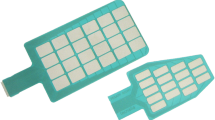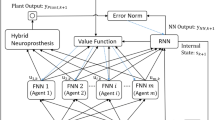Abstract
The use of functional electrical stimulation (FES) through neuroprosthesis is becoming a promising solution in lower limb neurorehabilitation. However, the wearability constraints and time-consuming tuning of stimulation parameters still limit the daily use of neuroprostheses. This work proposes two major contributions, namely: (i) a conceptual design and technical architecture of a fully wearable lower limb neuroprosthesis; and (ii) a Matlab-OpenSim framework that enables fast subject-and muscle-specific tuning of FES controllers based on OpenSim musculoskeletal models. The validation procedures for this study were divided into three phases: (i) Verification of the system architecture real-time requirements; (ii) evaluation of the reliability of the MATLAB-OpenSim framework for tuning PID controller; and (iii) its subsequent use in the neuroprosthesis control with a healthy subject. The obtained results demonstrated that the neuroprosthesis system was able to meet the real-time requirements, with control and data acquisition call periods below 10 ms. Further findings indicated reliable and stable behavior of the simulation-tuned PID controller with an overshoot of 9.82% and a rise time of 0.063 s. The trajectory tracking control results with the neuroprosthesis corroborated the robustness of the tuned PID controller in tracking the desired ankle trajectory (RMSE = 17.23 ± 2.97º and time delay = 0.21 ± 0.070 s).
This work has been supported by the Fundação para a Ciência e Tecnologia (FCT) through the Reference Scholarship under Grant SFRH/BD/147878/2019, the Stimulus of Scientific Employment under Grant 2020.03393.CEECIND, and in part by the FEDER Funds through the Programa Operacional Regional do Norte and national funds from FCT with the SmartOs project under Grant NORTE-01-0145-FEDER-030386. It is also supported under the national support to R & D units grant, through the reference project UIDB/04436/2020 and UIDP/04436/2020.
Access this chapter
Tax calculation will be finalised at checkout
Purchases are for personal use only
Similar content being viewed by others
References
W. H. Organization, “WHO | International perspectives on spinal cord injury,” WHO (2013). https://www.who.int/disabilities/policies/spinal_cord_injury/en/. Accessed 22 Apr 2020
Marquez-Chin, C., Bolivar-Tellería, I., Popovic, M.R.: Brain–computer interfaces for neurorehabilitation: enhancing functional electrical stimulation, 2nd edn. Elsevier BV. Amsterdam
Moreno, J.C., Figueiredo, J., Pons, J. L.: Exoskeletons for lower-limb rehabilitation. In: Rehabilitation Robotics: Technology and Application, London, United Kingdom. Elsevier, pp. 89−100 (2018)
Moreno, J.C., Mohammed, S., Sharma, N., Del-Ama, A.J.: Hybrid wearable robotic exoskeletons for human walking. INC (2019)
Molazadeh, V., Zhang, Q., Bao, X., Dicianno, B.E., Sharma, N.: Shared control of a powered exoskeleton and functional electrical stimulation using iterative learning. Front. Robot. AI 8(11), 1–13 (2021). https://doi.org/10.3389/frobt.2021.711388
Shah, M., Peterson, C., Yilmaz, E., Halalmeh, D.R., Moisi, M.: Current advancements in the management of spinal cord injury: a comprehensive review of literature. Surg. Neurol. Int. 10(174), 1–4 (2019). https://doi.org/10.25259/SNI
Seel, T., Laidig, D., Valtin, M., Werner, C., Raisch, J., Schauer, T.: Feedback control of foot eversion in the adaptive peroneal stimulator. In: 22nd Mediterranean Conference on Control and Automation, pp. 1482–1487 (2014). https://doi.org/10.1109/MED.2014.6961585
Ferrarin, M., Palazzo, F., Riener, R., Quintern, J.: Model-based control of FES-induced single joint movements. IEEE Trans. Neural Syst. Rehabil. Eng. 9(3), 245–257 (2001). https://doi.org/10.1109/7333.948452
Resquín, F., Pons, J.L., Brunetti, F., Ibáñez, J., Gonzalez-Vargas, J.: Feedback error learning controller for functional electrical stimulation assistance in a hybrid robotic system for reaching rehabilitation. Eur. J. Transl. Myol. 26(3), 255–261 (2016). https://doi.org/10.4081/ejtm.2016.6164
Müller, P., Del Ama, A.J., Moreno, J.C., Schauer, T.: Adaptive multichannel FES neuroprosthesis with learning control and automatic gait assessment. J. Neuroeng. Rehabil. 17(1), 1–20 (2020). https://doi.org/10.1186/s12984-020-0640-7
Kim, H., Park, G., Shin, J.H., You, J.H.: Neuroplastic effects of end-effector robotic gait training for hemiparetic stroke: a randomised controlled trial. Sci. Rep. 10(1), 1–9 (2020). https://doi.org/10.1038/s41598-020-69367-3
Pedrocchi, A., Ferrante, S., De Momi, E., Ferrigno, G.: Error mapping controller: a closed loop neuroprosthesis controlled by artificial neural networks. J. Neuroeng. Rehabil. (2006). https://doi.org/10.1186/1743-0003-3-25
Cardoso, A.C., et al.: A comparative study on control strategies for FES cycling using a detailed musculoskeletal model. IFAC-PapersOnLine 49(32), 204–209 (2016). https://doi.org/10.1016/j.ifacol.2016.12.215
Figueiredo, J., Carvalho, S.P., Vilas-Boas, J.P., Gonçalves, L.M., Moreno, J.C., Santos, C.P.: Wearable inertial sensor system towards daily human kinematic gait analysis: benchmarking analysis to MVN BIOMECH. Sensors (Switzerland) 20(8), 2185 (2020). https://doi.org/10.3390/s20082185
Müller, P., et al.: Adaptive multichannel FES neuroprosthesis with learning control and automatic gait assessment. J. Neuroeng. Rehabil. 17(1), 1–20 (2020). https://doi.org/10.1186/s12984-020-0640-7
Tucker, M.R., et al.: Control strategies for active lower extremity prosthetics and orthotics: a review. J. Neuro Eng. Rehabil. 12(1), 1 (2015). https://doi.org/10.1186/1743-0003-12-1
Bouri, M., Selfslagh, A., Campos, D., Yonamine, S., Donati, A.R.C., Shokur, S.: Closed-loop functional electrical stimulation for gait training for patients with paraplegia. In: 2018 IEEE International Conference on Robotics and Biomimetics, ROBIO, pp. 1489–1495 (2018). https://doi.org/10.1109/ROBIO.2018.8665270
Seth, A., et al.: OpenSim: simulating musculoskeletal dynamics and neuromuscular control to study human and animal movement. PLoS Comput. Biol. 14(7), e1006223 (2018). https://doi.org/10.1371/JOURNAL.PCBI.1006223
Koopman, B., van Asseldonk, E.H.F., Van der Kooij, H.: Speed-dependent reference joint trajectory generation for robotic gait support. J. Biomech. 47(6), 1447–1458 (2014). https://doi.org/10.1016/j.jbiomech.2014.01.037
Cavanagh, P.R., Komi, P.V.: Electromechanical delay in human skeletal muscle under concentric and eccentric contractions. Eur. J. Appl. Physiol. Occup. Physiol. 42(3), 159–163 (1979). https://doi.org/10.1007/BF00431022
Author information
Authors and Affiliations
Corresponding author
Editor information
Editors and Affiliations
Rights and permissions
Copyright information
© 2023 The Author(s), under exclusive license to Springer Nature Switzerland AG
About this paper
Cite this paper
Carvalho, S.P., Figueiredo, J., Santos, C.P. (2023). Wearable Lower Limb Neuroprosthesis: System Architecture and Control Tuning. In: Cascalho, J.M., Tokhi, M.O., Silva, M.F., Mendes, A., Goher, K., Funk, M. (eds) Robotics in Natural Settings. CLAWAR 2022. Lecture Notes in Networks and Systems, vol 530. Springer, Cham. https://doi.org/10.1007/978-3-031-15226-9_52
Download citation
DOI: https://doi.org/10.1007/978-3-031-15226-9_52
Published:
Publisher Name: Springer, Cham
Print ISBN: 978-3-031-15225-2
Online ISBN: 978-3-031-15226-9
eBook Packages: Intelligent Technologies and RoboticsIntelligent Technologies and Robotics (R0)




